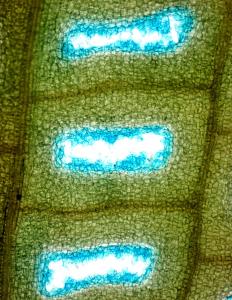abot92-11


Confocal optical section of a living chlorenchyma cell (stained with the nucleic
acid stain acridine orange) of Bienertia cycloptera, which possesses
a novel mechanism for C4 photosynthesis. Enzymes and organelles are
partitioned into two separate compartments within a single chlorenchyma cell.
The nucleus (green) is juxtaposed between a large, central cytoplasmic compartment,
densely packed with chloroplasts (red autofluorescence), and a peripheral compartment
with uniformly distributed chloroplasts. The cover is dedicated to co-author,
Vincent Raymond Franceschi (1953-2005), who contributed to the discovery of
single-cell C4 photosynthesis.
abot93-6

![abot93-6]()
Fluorescence in situ hybridization in a root tip metaphase squash of Nothoscordum striatum (Alliaceae) probed with concatemers of the human-type telomere motif (TTAGGG)n (biotin-labeled probe detected with cy3 avidin, red fluorescence; DAPI counterstain for DNA, blue fluorescence). The (TTAGGG)n minisatellite motif is found at chromosome ends (the telomeres). The authors showed that these motifs, and all investigated minisatellite repeats typical of eukaryote telomeres, are lost with the divergence of the genus Alllium from the rest of Alliaceae.
Link to
the AJB Abstract for the article:
Minisatellite telomeres occur in the family Alliaceae but are lost in Allium
by Eva Skorov
abot94-7


Light micrograph of a young leaf of lace plant at the perforation stage of
leaf development. The blue cells within three perforation sites that are undergoing
programmed cell death (PCD) are stained specifically for cell wall pectins by
alcian blue as a result of cuticle degradation. Adjacent living cells with intact
cuticle are not stained. The resculpting of a simple leaf blade is a unique
use of developmental PCD, known only for this species and for a handful of genera
in the aroid family. The accessibility and predictability of perforation formation
in lace plant leaves and the ability to propagate lace plant in sterile conditions
make the lace plant an attractive model for the study of developmental PCD in
plants. Scale bar = 100